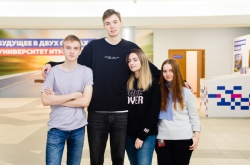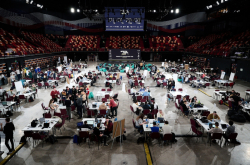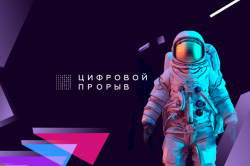What university did you graduate from and what do you do now?
Elena Selivanova: I completed my Bachelor’s and Master’s degrees in instrument engineering at ITMO University. And I also defended my PhD dissertation here. I am now a full-stack developer at the Arkadia company. We’re currently working on an educational platform called Itslearning. It is in many ways similar to the Russian platform Dnevnik.ru, but it is designed for both lower and higher degrees of education: from kindergartens and primary schools to colleges. Before that, I developed video surveillance systems for casinos.
Grigoriy Frantsuzov: I also studied instrument engineering at ITMO. After graduation, I first worked at a factory producing CNC machines, but after a while, I decided to become a programmer. For quite a long time, I was a co-founder of a company that produced speed cameras, which detect motoring offenses. Three years ago, I became a freelancer and now work on a range of projects.
Alexey Margolin: I also studied at ITMO, but I graduated from St. Petersburg State University of Industrial Technologies and Design. I work as a freelancer and a lecturer at CISCO (CCNA).

Denis Peshekhonov: I graduated from Peter the Great St. Petersburg Polytechnic University with a degree in electrical engineering. Already during my studies, I started participating in various projects to make some money, and then I began launching my own projects. By the moment I graduated from the university, I was an experienced programmer and already had a stable income. Now I work as a freelancer, too.
Why did you decide to take part in the hackathon? Did you have such an experience before?
Grigoriy Frantsuzov: It was me who came up with the idea. I really wanted to participate in this hackathon for a long time. This was my second time taking part in such a competition; the first one was the hackathon from Intel. It was dedicated to Intel’s embedded solutions on the Edison platform. Back then, the company actively promoted the platform in Russia. I really liked the atmosphere of the hackathon and I always wanted to participate in something similar. And then I learned about this VK Hackathon. I asked my friends interested in programming if they wanted to join me, and Denis volunteered. He suggested that we needed two front-end and two back-end developers in our team. I contacted Lena, while Denis invited Alexey. So Lena and I were responsible for back-end, and Denis and Alexey did front-end.

Why did you choose the Charity track?
Denis Peshekhonov: Actually, we took a very rational approach when choosing the track. After looking through all the tracks, we chose several that seemed the most exciting and evaluated each one according to three criteria: if it was interesting for us if it was technically feasible, and if there were much competition. Using this checklist, we found exactly what we were looking for. Charity is an interesting field, it’s easier to come up with something unique, especially in Russia, where there are not so many technical solutions in this area. Besides, the task was pretty clear, and we knew that we could do it. And last but not least, Lena and Grisha are donors themselves and they had some useful connections that might have come in handy.
Elena Selivanova: The other guys took on a more technical approach to choosing the track, but I wanted to do the DonorSearch case from the moment I heard about it. I am a donor myself and have long been aware of the problems existing in this field. What I also appreciated about this project was that it could help people; I was really attracted to this social aspect of the work.
Grigoriy Frantsuzov: When I was studying at ITMO, I was a member of the Student Council, and we organized the first Donor Day in the university’s history. It was as part of this that I met people from the Red Cross; they were promoting blood donation among students. For the next seven years, I was volunteering at the Red Cross, so I made lots of acquaintances among the specialists working there, who understood the complexities of both volunteering and blood donation and knew the process of attracting new donors in and out. That’s why I already had people to turn to and ask questions when I needed support. Different blood donation centers often have different requirements as to which contraindications you’ll have to consider and precautions you’ll have to make when donating, and it was invaluable for us to have someone that would clarify all this for us.

There were two cases in the Charity track. Why did you choose DonorSearch?
Grigoriy Frantsuzov: Yes, there were two organizations which presented their cases in the Charity track: DonorSearch (blood donations) and the Ray Fund which helps homeless animals. DonorSearch is a website which is a kind of a social network for donors, aimed at building communication between donors and blood donation centers.
Alexey Margolin: First, we were on the waiting list, because the competition was very intense. To be allowed to participate, you had to demonstrate strong interest and motivation. As we regularly asked questions, we were soon added to the main list.
Which problem did you need to solve for DonorSearch?
Elena Selivanova: The main goal of our website is to motivate users to donate their blood, as well as to attract new donors and retain regular donors, the ones that donate blood once per each two-three months. DonorSearch as a website and a mobile app for Android and iOS, which works as an alternative interface for the website and doesn’t perform any additional functions.

Grigoriy Frantsuzov: DonorSearch has at its disposal the tried-and-tested data on the working schedules of blood donation centers, their locations and needs for specific blood groups. For example, there could be situations where one center may have a surplus of the second blood group, but this is exactly the blood group that is lacking at another center. This information can be available at their websites, but it’s not all of the centers that can afford this, mostly the ones located in big cities. The rest upload this information in their groups on VK or opt for spreading the word in newsletters. By efforts of volunteers, DonorSearch processes this data and fills it in its database. As part of the hackathon, the representatives of the website provided us with a demo copy of their database together with its technical interface, which is a separate web portal for developers that allows them to obtain specific data by the way of special queries.
Because social media have such a massive reach, our task was to integrate all this to the social network VK into a single app, with a special prerequisite to display this app in the most convenient and accessible way for users. It was all the more significant given that the DonorSearch website itself grew from a mere VK group.
What solution did you propose?
Denis Peshekhonov: The app is included into the list of services available within VK’s framework so that users won’t need to bother themselves with downloading something or registering somewhere. Opening the app, users see three main tabs. The first allows them to enter their blood group and Rh factor and identify what exactly they can donate with their blood specifics: whole blood, plasma, erythrocytes, thrombocytes, or granulocytes. Before this project, I had no idea that you can donate something other than whole blood. This tab also enables you to enter your correct location; some people’s personal profiles indicate their hometown as their current location when they’ve moved long ago, and forgotten to change it in the social network.
Grigoriy Frantsuzov: The second tab is a map which shows all blood donation centers in the user’s location. The app draws on users’ geolocation data and displays all the stations available in the DonorSearch database for this specific city or town. It’s important to note that the map only displays the centers that accept the user’s blood group and Rh factor and have the need for it; sometimes the donation can be refused if a center has a surplus of this blood group. It’s also important to consider that not all of the centers are ready to accept new donors, as well as the donors who don’t have a residence permit for the city they live in, and it is in fact factored in by our map. Even more, it highlights the centers lacking the user’s blood group and Rh factor, indicating that these are the places they need to consider first and foremost.

Denis Peshekhonov: The third tab is the timeline representing the process of donating blood. It consists of different cards, each with its own unique function. For example, when you sign up for a blood donation, a special card appears indicating the contraindications, i.e. which criteria you’ll have to meet in order to donate blood. You also get a handbook with instructions on things you have to do before donating blood. From time to time, you’ll be receiving notifications with actions you need to take. You also have the opportunity to upload the donor certificates you get after each donation to the DonorSearch system. Once the certificate has been validated by experts, you can register for an appointment for your second blood donation: after three to six months after your first donation, you’ll need to confirm that you don’t have any diseases that can prevent you for donating blood for the second time. This tab also allows you to cancel your appointment.
Elena Selivanova: We invented a special feature that would motivate people to donate blood. It is considered that on average, each donation saves three lives, so DonorSearch keeps count for how many lives a user saves by each donation. We decided to go even further and make this count more graphic, and now the first tab of our app not only numbers, but also displays the lives you save as a donor. We plan on adding more formats of celebrating these accomplishments, such as interactive games and the opportunity for a user to invite his friends to donate their blood and unite in teams.
Were there any technical obstacles you had to tackle when working on this app?
Grigoriy Frantsuzov: The app consists of two parts, with the backend part connecting the interface to the data provided by DonorSearch. Because this data is very sensitive, we were forbidden to include it in a single database as that would violate the personal data policy, but we could still use it for a short amount of time to present our prototype.
Alexey Margolin: The app works on Android, iOS and other platforms which support the VK app. To create it, we used a special platform VK Apps, which gives our app access to VK users’ profiles.
What are your plans for the future?
Alexey Margolin: We’d love to, and in this we are supported by DonorSearch, to develop our invention into a fully operable product. This requires us to rewrite some features altogether, but we also have more time now to really think about it and study the user scenario in more detail. But our main goal, for now, is to make our app a 100% usable and launch it on VK, which is very eager to help us do that. Currently, it is only available as a demo version: it doesn’t allow users to register for an appointment, but they still can find all the addresses and schedules of blood donation centers they can visit. The time limit we had at the hackathon wasn’t enough to implement all of our ideas, so we only managed to a bare minimum. We just need some time to make it fully operable.

What helped you win the hackathon, in your opinion?
Grigoriy Frantsuzov: Our project offered a ready solution, fully complied with the task and successfully performed at the demo stage. We did have some concerns with our presentation being too simple, but it only contributed to our final success.
What was the most memorable about this hackathon for you personally?
Grigoriy Frantsuzov: This was the first time that the hackathon was held in the General Staff Building of the State Hermitage museum, which was the author of one of the six cases of the competition. It was a very unusual experience for us participants because we had the one-off opportunity to spend the whole day and night in this historic building and take a rest near the formidable Alexander Column.
Alexey Margolin: I first heard about VK Hackathon four years ago, when it was held at ITMO University and was a pretty low-scale event. This year, a total of 400 developers took part in the hackathon. Over the past four years, the number of teams has increased several-fold from 34 to 120, while the prize fund has risen from 300,000 rubles to 1,500,000 rubles. VK Hackathon is now one of the most large-scale events of this kind in Russia.

Do you plan to take part in such competitions in the future?
Grigoriy Frantsuzov: I think that we need some time to get over this hackathon and then we’ll start thinking about the next one. It was very interesting and rewarding but on the other hand, we wouldn’t like to participate in such events too often; two or four times a year would be perfect.



